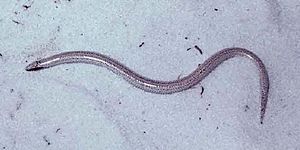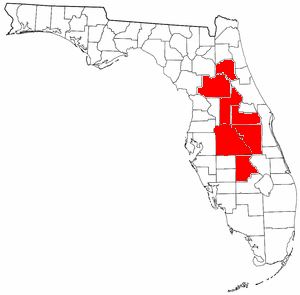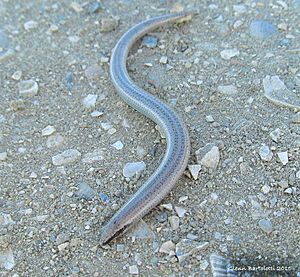Florida sand skink facts for kids
Quick facts for kids Florida sand skink |
|
|---|---|
 |
|
| Conservation status | |
| Scientific classification | |
| Genus: |
Plestiodon
|
| Species: |
reynoldsi
|
 |
|
| Florida sand skink range | |
| Synonyms | |
|
|
The Florida sand skink (Plestiodon reynoldsi) is a special type of lizard that lives only in Florida, United States. It belongs to the skink family. This amazing creature is known for living mostly underground, moving through loose sand as if it were swimming!
Contents
How the Florida Sand Skink Got Its Name
This unique lizard was first described in 1910 by a scientist named Leonhard Stejneger. He named it after Mr. A.G. Reynolds from Gulfport, Florida. Mr. Reynolds was the person who found the very first sand skink that scientists studied.
What Does the Florida Sand Skink Look Like?
The Florida sand skink is a small lizard, usually about 10 to 13 centimeters (4 to 5 inches) long. It has a gray or tan color that helps it blend in with the sand.
This skink has some really cool features that help it live underground:
- Its front legs are tiny and have only one toe each.
- Its back legs are also small and have two toes.
- It has a wedge-shaped head, which helps it push through sand.
- Its lower jaw is partly tucked in, which keeps sand out of its mouth.
- Its small eyes have clear "windows" on the lower lids, so it can see even when its eyes are covered by sand.
- It can fold its tiny front legs into special grooves on its body.
All these features make it perfect for burrowing and moving easily through loose sand.
What Do Florida Sand Skinks Eat?
The Florida sand skink eats small creatures that live on or near the surface of the sand. Its diet mainly includes termites, spiders, and the young (larvae) of antlions and beetles. It usually finds its food by burrowing just under the soil.
Life Cycle and Reproduction
Florida sand skinks are most active in the spring. This is their mating season. They become old enough to have babies after one to two years. They can continue to reproduce for about two to three years.
About 55 days after mating, the female skink lays around two eggs. These eggs usually hatch in June or July.
Where Do Florida Sand Skinks Live?
The Florida sand skink lives only in Central Florida. In 1999, scientists knew of 115 places where these skinks lived. However, they are hard to find, so there might be more places where they live.
You can find them in areas like the Lake Wales Ridge, the Winter Haven Ridge in Polk County, and the Mount Dora Ridge.
What Kind of Home Do They Like?
Florida sand skinks prefer to live in areas with specific types of plants. These include places with sand pine and Florida rosemary shrubs. They also like areas with longleaf pine trees and American turkey oak trees.
They are often found where different habitats meet, like between Florida rosemary scrub and palmetto-pine flatwoods. These spots are good because there is usually moisture under the leaves and in the sand, which the skinks need.
How Do Florida Sand Skinks Behave?
These lizards spend most of their time underground. They dig tunnels about 5 to 10 centimeters (2 to 4 inches) deep to find food and stay safe.
Why Are Florida Sand Skinks in Danger?
The Florida sand skink is considered a vulnerable species. This means it is at risk of becoming endangered if its habitat continues to shrink.
Since 1987, the United States Fish and Wildlife Service has listed it as a threatened species. The main reasons they are in danger are:
- Habitat destruction: Their homes are being destroyed to build new houses and buildings.
- Farms: Land is being cleared for citrus fruit farms.
- Mining: Areas are being dug up for phosphate mining.
- Wildfires: Large fires can destroy their habitat.
Scientists and conservation groups like the IUCN are working to protect these unique lizards and their homes.
See also
 In Spanish: Eslizón de arena de Florida para niños
In Spanish: Eslizón de arena de Florida para niños



